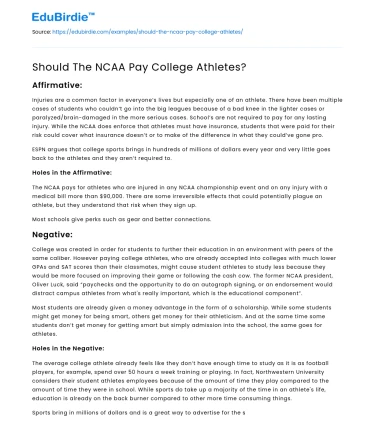Affirmative:
Injuries are a common factor in everyone’s lives but especially one of an athlete. There have been multiple cases of students who couldn’t go into the big leagues because of a bad knee in the lighter cases or paralyzed/brain-damaged in the more serious cases. School’s are not required to pay for any lasting injury. While the NCAA does enforce that athletes must have insurance, students that were paid for their risk could cover what insurance doesn’t or to make of the difference in what they could’ve gone pro.
ESPN argues that college sports brings in hundreds of millions of dollars every year and very little goes back to the athletes and they aren’t required to.
Save your time!
We can take care of your essay
- Proper editing and formatting
- Free revision, title page, and bibliography
- Flexible prices and money-back guarantee
Holes in the Affirmative:
The NCAA pays for athletes who are injured in any NCAA championship event and on any injury with a medical bill more than $90,000. There are some irreversible effects that could potentially plague an athlete, but they understand that risk when they sign up.
Most schools give perks such as gear and better connections.
Negative:
College was created in order for students to further their education in an environment with peers of the same caliber. However paying college athletes, who are already accepted into colleges with much lower GPAs and SAT scores than their classmates, might cause student athletes to study less because they would be more focused on improving their game or following the cash cow. The former NCAA president, Oliver Luck, said “paychecks and the opportunity to do an autograph signing, or an endorsement would distract campus athletes from what's really important, which is the educational component”.
Most students are already given a money advantage in the form of a scholarship. While some students might get money for being smart, others get money for their athleticism. And at the same time some students don’t get money for getting smart but simply admission into the school, the same goes for athletes.
Holes in the Negative:
The average college athlete already feels like they don’t have enough time to study as it is as football players, for example, spend over 50 hours a week training or playing. In fact, Northwestern University considers their student athletes employees because of the amount of time they play compared to the amount of time they were in school. While sports do take up a majority of the time in an athlete's life, education is already on the back burner compared to other more time consuming things.
Sports bring in millions of dollars and is a great way to advertise for the school. The education stand point is important but in no way brings in the same amount of money as football.






 Stuck on your essay?
Stuck on your essay?

